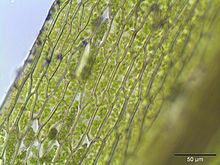Reddish pohlmoss
| Reddish pohlmoss | ||||||||||||
|---|---|---|---|---|---|---|---|---|---|---|---|---|

Reddish pohlmoss ( Pohlia melanodon ) |
||||||||||||
| Systematics | ||||||||||||
|
||||||||||||
| Scientific name | ||||||||||||
| Pohlia melanodon | ||||||||||||
| ( Brid. ) AJShaw |
The reddish pohlmoss ( Pohlia melanodon ) grows in loose to moderately dense, mostly small, up to 1 cm high, dirty green to brownish-green , reddish-colored below. It is not infrequently overlooked because of its indistinct characteristics or confused with other Pohlia species.
Identifying features
The plants shine only when they are moist, when they are dry they are clearly matt. Particularly characteristic is the reddish stem, which has slightly bent dry leaves that stick out when wet and are 3 to 5 times as long as they are wide. They are gradually pointed, often reddish in color at the bottom and ovoid to lanceolate in shape. The upper crested leaves are always longer and narrower than the leaves below. The leaf edge is often slightly bent and can be sawn in the middle. The reddish midrib usually ends in front of or in the tip of the leaf. The thin-walled lamina cells are elongated, rhombic, 4 to 6 times as long as they are wide and in the middle of the leaf about 60 to 75 µm long and 11 to 20 µm wide. The leaf margin is slightly bordered by 1 or 2 rows of narrower cells. Often elongated, pearl-like and transparent rhizoid gems are formed on the rhizoids, which are used for vegetative reproduction. The yellowish reddish seta is up to 2 cm long and has a hooky curve and thickens at the tip. The conical to hemispherical spore capsule is pendulous, reddish-yellow to brownish-red in color and suddenly narrows into a slightly curved neck. The outer, brown-red peristome has 25 to 30 lamellae. The inner peristome, on the other hand, is yellowish in color. The spores have a diameter of 14 to 20 µm and are often finely punctured. Spore ripening occurs relatively rarely in early spring.
Occurrence
The pioneering Reddish Pohlmoos colonizes lime or base-rich, fresh, moist to wet, moderately nutrient-rich, light to partially shaded locations. It grows naturally on loamy or clayey, open earth on eruptions of gorges, on steep slopes of water banks and secondarily on stubble fields, on forest paths, on peat cutouts, in embankments and roadsides. Some Dicranella species are common accompanying mosses .
Individual evidence
- ^ Theo Arts: The occurrence of moniliform tubers in Pohlia melanodon (Brid.) J. Shaw, the differences between juvenile plants of related species and their distribution in Belgium and the Grand-Duchy of Luxembourg. In: Bulletin de la Société Royale de Botanique de Belgique. Vol. 119, No. 1, 1986, ISSN 0037-9557 , pp. 114-120, JSTOR 20794077 .
literature
- Martin Nebel, Georg Philippi (ed.): The mosses of Baden-Württemberg. Volume 2: Special part, (Bryophytina II, Schistostegales to Hypnobryales). Ulmer, Stuttgart 2001, ISBN 3-8001-3530-2 .
- Jan-Peter Frahm , Wolfgang Frey : Moosflora (= UTB . 1250). 4th, revised and expanded edition. Ulmer, Stuttgart 2004, ISBN 3-8252-1250-5 .

